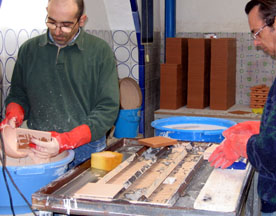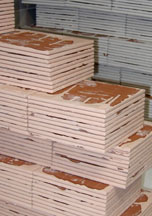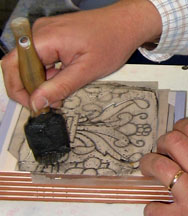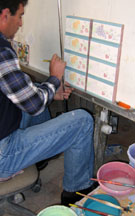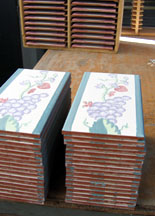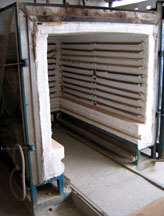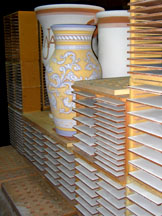Earthenware Tiles and Ceramics of Seville
The 12th century Moors were the first in
Spain to decorate the walls, floors, ceilings, and facades of their religious and
secular buildings with colorful tiles laid in geometric patterns. Figurative motifs were introduced during the Renaissance period.
|
Five types of tiles were used to cover the walls, floors, and garden
benches of the Alcazar in Seville. |
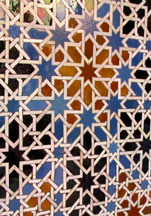 |
 |
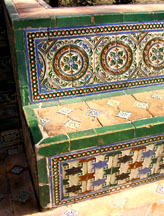 |
 |
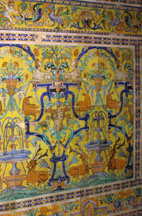 |
|
Labor-intensive alicatado tiles were glazed, fired, then shaped
with pliers and filed smooth (each
color is a different tile). |
These tiles were shaped and glazed before firing. |
The raised lines on the rectangular press-molded arista relief
tiles keep the glazes from running together during firing. |
The cuerda seca
(dry cord) technique originated in southern Spain in the 15th century. It
was used on these rectangular tiles to separate the glazes. |
Renaissance-inspired figurative motifs were painted on flat square tiles with tin and lead
glazes. |
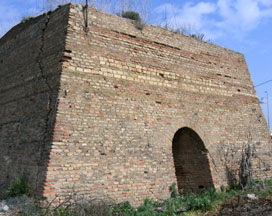 |
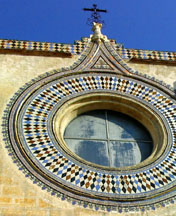 |
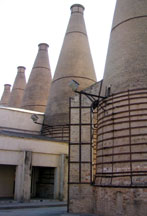 |
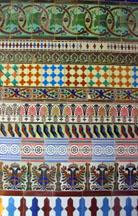 |
|
An abandoned wood-fired "Arab" kiln on the outskirts of Seville. |
La Cartuja was first a monastery, then a tile factory. Today the
restored buildings and kilns host the Centro Andaluz de Arte Contemporáneo,
a modern art museum. |
Cuerda seca and Renaissance-inspired figurative motifs
may be seen today when visiting ceramic studios in Seville.
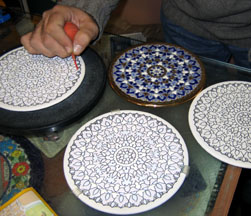 |
 |
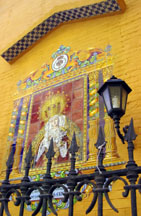 |
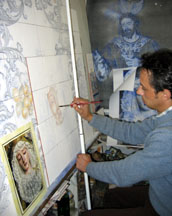 |
|
A mixture of manganese and olive oil is still used by
most cuerda
seca ceramists to separate the glazes. The glaze is applied with an ear
syringe between the painted lines. A fired piece is shown in the
upper center. |
Each of the forty- eight Spanish provinces is
commemorated with a tiled exhibition space at the Plaza de España. |
Tile Shrines are found on most churches. This one is on
the facade of Los Terceros. |
Manuel Carillo paints the Virgin on tiles at Cerámica Ruiz
Gil, 11 Calle Antillano Campos, Triana, 41003 Seville, Tel: 954 331
390. |
| Taller de Cerámica
has been making original pieces and reproductions of 17th and 18th century tiles, plates, and
vessels for more than 30 years.
They may be contacted at 25 Calle Aguilas, 41003 Seville, Tel: 954 211
626. |
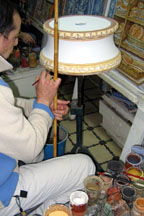 |
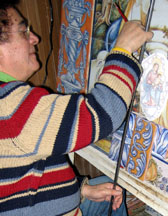 |
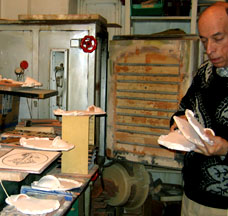 |
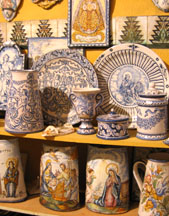 |
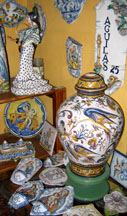 |
LINKS:
Earthenware Ceramics of Ubeda, Spain
Tiles and Ceramics of Talavera de la Reina, Spain
Monje Ceramics of Lora del Rio, Spain
Earthenware Tiles of Portugal
Majolica Ceramics of Caldas da Rainha, Portugal
Blacksmithing in Andalucia, Spain
Sculpture of Seville, Spain
Silversmithing of Seville, Spain
Metal Spinning of Seville, Spain
Marquetry of Granada, Spain
Capelo of Guanajuato, Mexico
Angelica Escarcega Rodriguez of Guanajuato, Mexico
José Luis Méndez Ortega of Guanajuato, Mexico
Guevara Ceramics of Guanajuato, Mexico
Tecpatl Ceramics of Guanajuato, Mexico
Maya Reproductions of the Yucatan
Pottery of Western Cameroon
Traditional Dunzi Production in Yaoli, China
Porcelain Production in Jingdezhen, China
Roof Tiles in Bali, Indonesia
History of Mayolica in Spain and Mexico
Web page, photographs, and text by Carol Ventura in 2005. Please look at
Carol's home page to see more about crafts around the world.


















